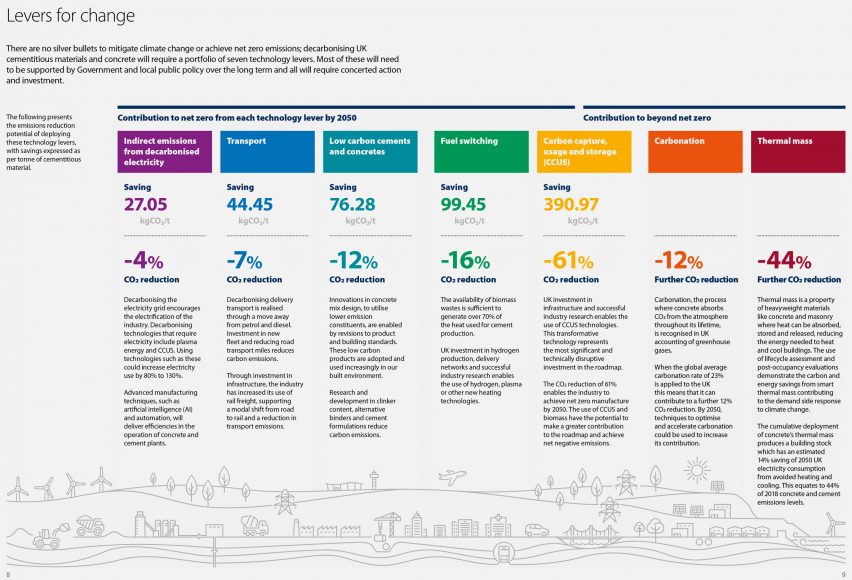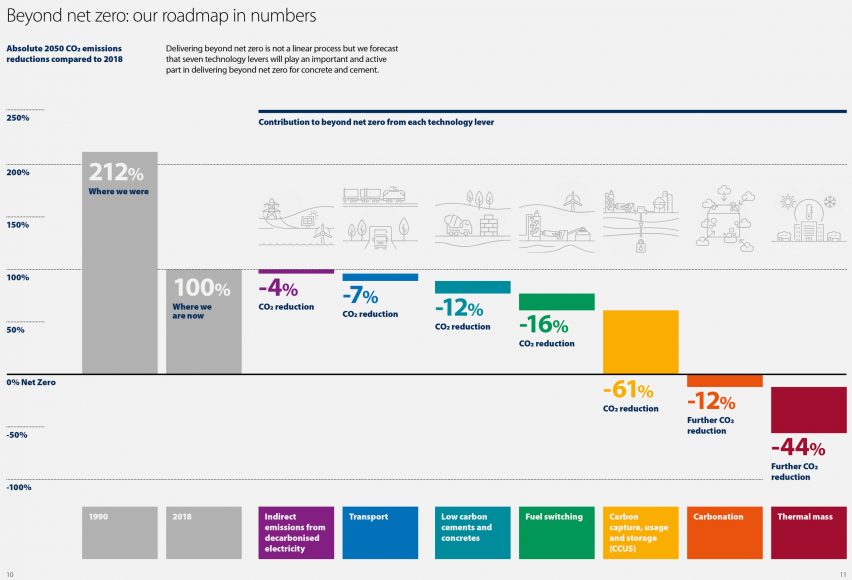
UK cement industry sets out roadmap to "go beyond net-zero" by 2050
UK producers are trialling new types of cement production methods and testing low-carbon concrete recipes in a bid to eliminate carbon emissions and become a net-zero industry.
The moves are part of a roadmap that identifies seven ways of decarbonising the industry with the aim of going "beyond net-zero" by 2050.
These include running production plants and supply chains on renewable energy, making use of nascent carbon-capture technologies and taking into account the way concrete and cement structures absorb carbon over their lifetimes.
The industry "can actually go beyond net-zero if we have a fair wind and all the right enablers from governments and the technological development that we hope will occur," said Richard Leese, director of industrial policy at the Mineral Products Association (MPA), which represents the UK's cement industry.
"For our decarbonisation journey, clearly we've got to get the designers and structural engineers to take on board the new products," he added.
Cement is largest industrial source of CO2
The net-zero roadmap comes as the industry faces growing scrutiny over its emissions. A landmark 2018 report by Chatham House found that it is responsible for around eight per cent of global emissions, making it the single-largest industrial source of atmospheric CO2.
Moves to tackle cement emissions include plans to turn a Swedish facility into "the world's first carbon-neutral cement plant".
The seven "levers" to decarbonising the UK sector are set out in the UK Concrete and Cement Industry Roadmap to Beyond Net Zero, which was published last October by the MPA.

The document claims the UK industry, which produces 90 million tonnes of concrete each year, has "already delivered a 53 per cent reduction in absolute carbon dioxide emissions since 1990."
This has been achieved by moving away from fossil fuels to power production and using "secondary cementitious materials" including industrial byproducts, such as fly ash and ground granulated blast furnace slag, to replace clinker made by burning limestone.
As a result, emissions from the sector today represent 1.5 per cent of all UK emissions rather than the eight-per-cent global average, the MPA claims.
Cement production "needs to be net-zero"
"We've done the low-hanging fruit," said Jenny Burridge, principal structural engineer at the MPA's Concrete Centre in London.
"We need to be net-zero," she added. "In order to get from one and a half per cent of the total to nothing is quite a big thing to have to try and do. So this is going to be the more difficult bit."
As part of the plan, the Hanson Cement plant at Ribblesdale in North Yorkshire is about to trial the use of hydrogen and biomass to power its kilns. The experiment will see the percentage of low-carbon fuels slowly increase up to around 30 per cent of the total fuel mix.
However, the gas used will be "blue" hydrogen, which is extracted from fossil fuels using a process that generates carbon emissions, rather than "green" hydrogen, a zero-carbon fuel that is extracted from water and powered by renewable energy.
A second plant is due to start a trial using electric plasma energy together with biomass.
"Both of these will be world firsts because nobody's truly tried it at commercial scale," said Leese.
Low-carbon cement and renewable energy use could reduce emissions
Switching cement production to renewable energy could reduce the industry's CO2 emissions by 20 per cent, according to the roadmap, while decarbonising transport could save a further seven per cent.
An additional 12 per cent reduction in emissions could come from new types of low-carbon cement. Traditional Portland cement contains clinker made from limestone, which is crushed and burned in a process that generates vast amounts of carbon emissions.

The MPA has been trialling low-carbon cements that use alternative materials as clinker and hopes to get concrete certification standards changed so these can be used commercially.
"Test work has been carried out by the Building Research Establishment over the last couple of years," said Leese. "We're writing that up so we can change the concrete standard BS 8500 so those low-carbon cements can be used in the marketplace. So that's hugely important news."
A demonstration project showcasing concrete made from the new cements is due to be unveiled next month.
The biggest potential decarbonising levers are carbon capture and storage (CCS) and carbon capture and utilisation (CCU). These involve capturing CO2 before it reaches the atmosphere and either burying it underground or using it as an ingredient in materials and products.
If fully exploited, this could reduce emissions by 61 per cent, but CCS and CCU technology have a long way to go and costs need to fall dramatically before they are viable.
MPA and UK government working on carbon capture
The MPA is working with the UK government's Department for Business, Energy & Industrial Strategy (BEIS), which is identifying ways of capturing large quantities of CO2 captured from industrial plants and storing it in oil and gas fields beneath the North Sea.
"BEIS is developing the business models that will help to deploy not just the carbon capture at industrial plants but also the CO2 transportation infrastructure, the storage sites and the regulatory models around that," said Leese.
"The UK has got an abundance of potential CO2 storage sites," he added. "We're talking hundreds of millions of tonnes of CO2."
The initiative is similar to Project Longship, Norway's €1.7 billion scheme to bury up to 1.25 billion tonnes of captured CO2 in depleted North Sea fossil reserves.
"I guess they're a bit ahead of us in the deployment of carbon capture but all that knowledge is getting transferred to the UK so we can use it," Leese said.
The sixth decarbonising lever is carbonation, which is the process by which cement and concrete structures absorb atmospheric carbon through their surfaces.
This is something that already happens naturally but its impact has been overlooked, the MPA believes. If this was taken into account, it could knock 12 per cent off UK cement emissions.
"The uptake of CO2 in cement infrastructure (carbonation) offsets about one-half of the carbonate emissions from current cement production," according to the recent IPCC climate report.
"The key chapter in [the IPCC report] recognised concrete carbonation for the first time," Leese told Dezeen. "Now the international accounting needs to be updated to take account of the carbonation of concrete just so they can get the math right."
Concrete could become a carbon sink
The MPA is researching how much carbon is absorbed by different types of concrete and cement and exploring how to develop formulas that could help turn the material into a carbon sink rather than a carbon emitter.
"Concrete absorbs CO2," said Burridge. "We haven't been talking about it very much. But actually, that's one of the things that we're looking at at the moment."
Different types of concrete carbonate at different rates. Reinforced concrete needs to avoid absorbing carbon since carbonation corrodes the steel reinforcements, but products such as non-structural blockwork could be used to store carbon. "Blocks actually carbonate quite quickly," Burridge said.
Crushed concrete has even greater potential since it has a greater surface area that can absorb more CO2, Burridge said.
"There are huge arguments for not knocking a building down," she said. "But if you do knock it down, you should make sure that you crush the concrete up because then the carbonation happens quite quickly."
The crushed concrete can be recycled and used as aggregate, she added.

Cement is traditionally cured by adding water but alternatives are being developed that suck carbon from the atmosphere as part of the curing process.
"There are some types of cement that actually cure by absorbing CO2," Burridge said. "They're not in the mainstream yet but there are people doing work on cements that cure by carbonation."
The final lever in the MPA roadmap is thermal mass, which it claims could lead to an additional 44 per cent reduction in emissions and help make the UK cement sector a net absorber of atmospheric carbon.
The MPA's argument is that concrete's high thermal mass means the material can help regulate interior temperatures, thereby lowering energy use, which means fewer emissions from the energy grid.
UK to decarbonise power grid by 2035
However, the UK's carbon budget commits the nation to decarbonising its power grid by 2035, by which point it must rely on renewable sources and nuclear.
The MPA counters by arguing that reducing the energy needs of buildings will play a vital role in minimising the cost of the energy transition.
"The Committee on Climate Change told the government that the electricity grid needs to be at least twice, if not three times the size of the current electricity grid by 2050," Leese said, referring to the CCC's Sixth Carbon Budget, which was published last year and became legally binding in June.
"So the cost of that infrastructure and the cost of managing the intermittency [balancing fluctuations in power generation with fluctuations in demand] of renewables is huge. And that will no doubt be the biggest cost for society moving towards net-zero."
Net-zero means that a project or organisation makes zero contribution to atmospheric CO2 across its entire value chain. Any emissions that cannot be eliminated must be offset using credible schemes that remove carbon from the atmosphere.
Companies in the architecture and design sector that have committed to becoming net-zero include Danish furniture brand Takt, Swedish cosmetics brand Forgo plus a handful of UK architects that have joined RIBA's climate challenge.
Dezeen has also pledged to become net-zero by 2025.
Main image: Peter Zumthor's Secular Retreat in Devon, England is constructed from concrete rammed by hand.